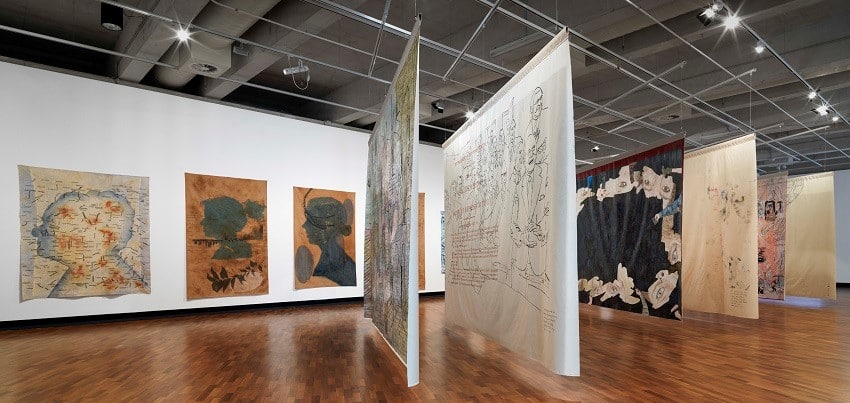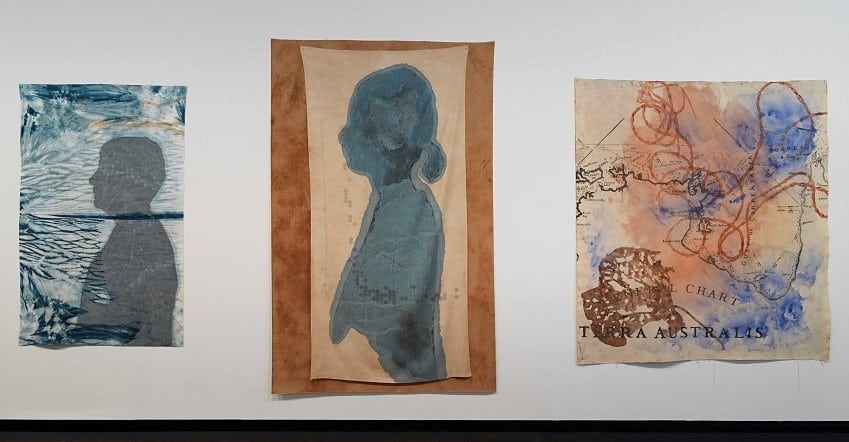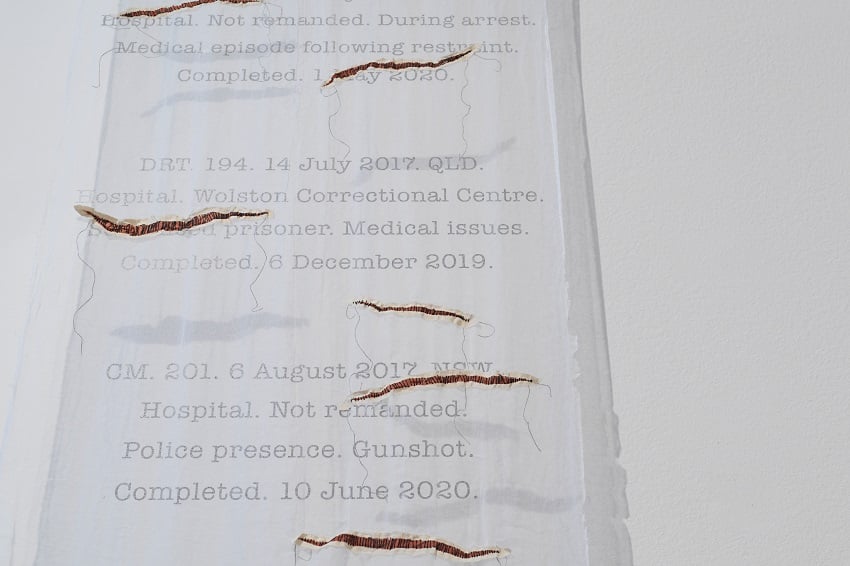‘Judy Watson and Helen Johnson: the red thread of history, loose ends’ is a significant body of work by two of Australia’s leading female artists Judy Watson and Helen Johnson brought together in a creative and historically inspired dialogue concerning past and present experiences of women in colonial and contemporary Australia.

‘the red thread of history, loose ends’ is an NGA travelling exhibition on display in Canberra until 5 June and at Melbourne’s Monash University Museum of Art (MUMA) from 10 September to 12 November.
The exhibition is curated by National Gallery of Australia’s Tina Baum, Gulumirrgin (Larrakia)/Wardaman/Karajarri peoples, Curator, Aboriginal and Torres Strait Islander Art, with Elspeth Pitt, Curator, Australian Art, and Jaklyn Babington, former Senior Curator, Contemporary Art.
Paired for their shared interests in Australia’s history of colonisation and their personal experiences as women and those of their matrilineal ancestors, Watson and Johnson, who had not worked together nor met previously, make an exciting creative duo.
“Their perspectives are coming from different angles of course but their works are really quite similar in talking about the female experience, womens voice, and the layering of icons and text,” says Baum.

Judy Watson is a Waanyi woman and artist living and working on Jagera/Yuggera and Turrbal Country of Meanjin/Brisbane, who is deeply connected to her Ancestor’s country and her own lines of matrilineal kinship. Her artistic practice involves drawing, printmaking, painting, installation, sculpture, and video, which she uses to bring Aboriginal histories and untold truths into view, to protest, and celebrate Waanyi culture. Helen Johnson is a second-generation immigrant of Anglo-Saxon descent who lives and works on Wurundjeri Woiwurrung Country in Naarm/Melbourne. Her often layered figurative and abstract compositions, which she executes on large-scale soft falling canvas unravels official histories and colonialisms in Australia and the ongoing impact these issues have on society and politics today.
“The title of the exhibition relates to red ochre for First Nations people around the world. Red ochre is really quite important. Henry Parkes in his speech spoke about how the crimson thread of history ties the country together. Looking at those sorts of references, records from the archives and really important stories like Judy’s great-great-grandmother who survived a massacre to those early policies and the policies in Helen Johnson’s work about how this country was built, there are some interesting links both content wise and visually across the entire space,” says Baum.
The exhibition is arranged within the gallery in such a way that the artist’s dialogue can travel between and across the entire body of work. Johnson’s installation of three sets of two very large paintings marked on both sides of the canvas hangs in the centre of the exhibition inviting audiences to weave in and out of them, while Watson’s artworks also large in scale are placed around the gallery walls forming “a layer around the Australian colonial perspective or critic in the middle”.
“The sight lines in the exhibition are really important where they connect up stories.” For example, these connective paths are evident “when you’re looking through some of Helen’s works where there’s a lot of text to do with reports or documents that look through to the text on the wall of the names of 51 Aboriginal people who have died in police custody,” Baum says.

Through the sharing of their knowledge, research and creativity during the development and delivery of this project Watson and Johnson “have formed a really special, respectful friendship. Their sensibilities and the way they think are really quite in tune with each other. It’s such a beautiful pairing. Besides the works all being absolutely beautiful there is a really big layering of messages in the work, which I hope audiences will get,” Baum shares.
‘The red thread of history, loose ends’ is a Know My Name project developed by the NGA as a gesture of affirmative action towards the institution’s commitment to increase the representation of all women across its artistic program, collection development, and organisational structures, and is presented as part of The Balnaves Contemporary Series designed to support artists in the making new work.
All images: Installation view, Judy Watson & Helen Johnson: the red thread of history, loose ends, National Gallery of Australia, Kamberri/Canberra, 2022. Courtesy the artists and National Gallery of Australia